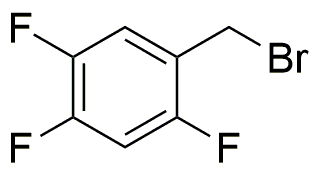2,4,5-Trifluorobenzyl bromide is widely utilized in research focused on:
- Synthetic Chemistry: This compound serves as a key intermediate in the synthesis of various pharmaceuticals and agrochemicals, allowing researchers to create complex molecules efficiently.
- Fluorinated Compounds: Its unique trifluoromethyl group enhances the biological activity of compounds, making it valuable in the development of new drugs with improved efficacy and selectivity.
- Material Science: Used in the production of fluorinated polymers, it contributes to materials with enhanced thermal stability and chemical resistance, which are essential in high-performance applications.
- Bioconjugation: The bromide functionality allows for easy attachment to biomolecules, facilitating the creation of targeted drug delivery systems and diagnostic agents in biomedicine.
- Research Reagents: As a versatile reagent, it is employed in various chemical reactions, providing researchers with a reliable tool for exploring new chemical pathways and reactions.
General Information
Properties
Safety and Regulations
Applications
2,4,5-Trifluorobenzyl bromide is widely utilized in research focused on:
- Synthetic Chemistry: This compound serves as a key intermediate in the synthesis of various pharmaceuticals and agrochemicals, allowing researchers to create complex molecules efficiently.
- Fluorinated Compounds: Its unique trifluoromethyl group enhances the biological activity of compounds, making it valuable in the development of new drugs with improved efficacy and selectivity.
- Material Science: Used in the production of fluorinated polymers, it contributes to materials with enhanced thermal stability and chemical resistance, which are essential in high-performance applications.
- Bioconjugation: The bromide functionality allows for easy attachment to biomolecules, facilitating the creation of targeted drug delivery systems and diagnostic agents in biomedicine.
- Research Reagents: As a versatile reagent, it is employed in various chemical reactions, providing researchers with a reliable tool for exploring new chemical pathways and reactions.
Documents
Safety Data Sheets (SDS)
The SDS provides comprehensive safety information on handling, storage, and disposal of the product.
Product Specification (PS)
The PS provides a comprehensive breakdown of the product’s properties, including chemical composition, physical state, purity, and storage requirements. It also details acceptable quality ranges and the product's intended applications.
Certificates of Analysis (COA)
Search for Certificates of Analysis (COA) by entering the products Lot Number. Lot and Batch Numbers can be found on a product’s label following the words ‘Lot’ or ‘Batch’.
*Catalog Number
*Lot Number
Certificates Of Origin (COO)
This COO confirms the country where the product was manufactured, and also details the materials and components used in it and whether it is derived from natural, synthetic, or other specific sources. This certificate may be required for customs, trade, and regulatory compliance.
*Catalog Number
*Lot Number
Safety Data Sheets (SDS)
The SDS provides comprehensive safety information on handling, storage, and disposal of the product.
DownloadProduct Specification (PS)
The PS provides a comprehensive breakdown of the product’s properties, including chemical composition, physical state, purity, and storage requirements. It also details acceptable quality ranges and the product's intended applications.
DownloadCertificates of Analysis (COA)
Search for Certificates of Analysis (COA) by entering the products Lot Number. Lot and Batch Numbers can be found on a product’s label following the words ‘Lot’ or ‘Batch’.
*Catalog Number
*Lot Number
Certificates Of Origin (COO)
This COO confirms the country where the product was manufactured, and also details the materials and components used in it and whether it is derived from natural, synthetic, or other specific sources. This certificate may be required for customs, trade, and regulatory compliance.


